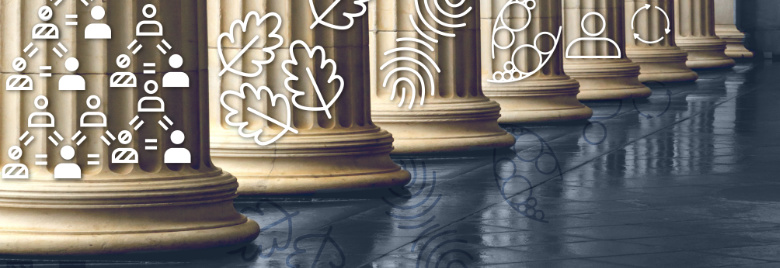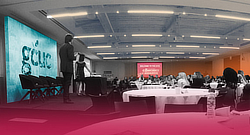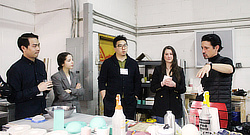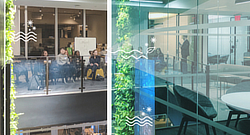Six Pillars of a Desirable Workplace

Is your office built for superheroes?
It’s summer blockbuster season, and the superhero movie still reigns at the box office. Any fan of the genre will tell you that a good superhero tale starts with a great origin story. We’d like to think we’re superheros of social research-based workplace optimization. Jump into Wonder Woman pose and check out this month’s "On our minds", where we reach into the past to reveal how PLASTARC began with six principles for building spaces that help your team save the workday.
On our minds
Back in 2012, we identified six pillars of a desirable workplace, and a few months later PLASTARC emerged from a phone booth (of course) to put these ideas into practice. At the time, some were as much a statement of intent as a recognition of facts on the ground. In the years since, aided by PLASTARC’s award-winning work on projects far and wide, these have all been embraced to varying degrees by savvy leaders in organizations large and small. If you’re a frequent reader of our communiques, you’ve certainly seen some of these before. Others may be new.
Diversity
Our last newsletter touched on the importance of choosing to make our spaces welcoming to all. It’s not just the right thing to do; it’s also the smart thing to do. Having a broader range of backgrounds and ideas in the room is a strategic asset. To get the best out of your team, and to build a resilient organization that stands the test of time, build diversity in space to enable diversity in user population.
Autonomy
At this point it’s well-known that great talent doesn’t need (or want) to be micromanaged. Only in the last few years have businesses begun to realize that self-direction is actually one of the crucial components of motivation. The amenities and technology of your organization can enable people to take initiative - or stifle them. People should be invited to choose a space that meets their needs. The best places offer flexibility in where, when and how to work.
Authenticity
"Authentic" is a word that’s usually applied to individuals. People can sense when they’re talking to someone who isn’t being authentic, and most of us don’t like it very much.
We at PLASTARC are big fans of psychologist Daniel Kahneman’s work, including his book Thinking, Fast and Slow. In it, he highlights just how much snap judgements about people and environments can shape our decisions.
There are no neutral design choices; every design element conveys meaning, intended or not. What is the design of your organization’s environment communicating? Is it warm and welcoming? Clean and modern? Bauhaus or boathouse?
For example, the way space is allocated says a lot; if an organization claims to value teamwork and collaboration, but their entire office is wall-to-wall cubicles, then the space is undercutting those values. Workplace is an opportunity for organizations to "walk the talk".
A space should reflect and support both the culture and needs of its human occupants. It should represent the history of the institution, positive and negative, rather rather than eliminating or erasing that history. It should tell newcomers something about the company and its people.
Propinquity
This might be our favorite Scrabble word. Urban planners have plenty of data to show that as the density of a city rises, productivity and output rise even faster. This isn’t just about physical proximity, though; people have to interact. Propinquity encompasses both physical closeness and closeness of relationships. Together, these can drive collaboration.
This turns out to be true for people at work too, as we’ve written before. Being close to each other improves mental health and cognitive performance, and increases opportunities for collaboration.This isn’t a call for more cube farms. The idea is to maximize productive serendipity by designing for it.
If, for example, people doing very similar jobs are clustered in physical space, they are likely to have similar information. Put two people with totally different jobs right next to each other, and they may struggle to find any overlap. Neither of those is bad per se, but they also aren’t optimal. Getting the balance just right takes careful planning and design thinking.
After all, people in space are like molecules in a box; the more you put in, the more likely they are to run into each other. The greatest driver of interaction is density.
As coworking and remote work continue to decentralize the office experience, how can we keep creating opportunities for serendipity? What kinds of design solutions can accommodate the changing nature of work while still promoting interaction? These are the kinds of problems we love to solve.
Reusability
Think about your home. Be it a mansion or a studio apartment, its most important and most-loved features are its evolving reusable spaces. A living room can also be a movie theater, or a place to read quietly. A kitchen table becomes a place for kids to do homework, or for a family to play a game. Aside from their physical utility, they’re also where many families communicate and build relationships. Simple and adaptable spaces invite people to use them for any purpose, individually and together.This multipurpose space is also more efficient than having separate spaces for each activity.
Sustainability and wellness
If an organization’s people are its most important asset, then their wellbeing is its most important investment. There is ample evidence that the spaces we work in and the activities those spaces promote have an immediate impact on our wellness and our ability to thrive long-term. A tight labor market means top-tier talent have the freedom to choose a company that’s committed to their well-being.
A super team
As you’ve likely deduced faster than a speeding bullet, these pillars are interdependent. Autonomy can enable propinquity. Diversity can promote sustainability. Reusability can feed authenticity. Enabling any one can make a difference, but a commitment to all six will help your organization build a place and a team that’s ready to take on the world.
From the archives
We’ve been thinking about how space affects interactactions for years. In this video of our 2017 panel for Cornell’s School of Industrial and Labor Relations, we talked about the changing expectations around workplace. PLASTARC’s work with Verizon, including on their new coworking space in Singapore (opening next week), showed how coworking enables people to work in spaces that work for them.
We love using data to improve the user experience. It’s like the superpower of being everywhere at once! Back in 2014, we wrote about the implications of location intelligence technology as it enters the workplace.
That’s all for this edition. Next time we’ll offer some reflections on London’s Millennium Bridge, which turns 18 this June. Until then, drop us a line if one of our six pillars has piqued your interest - or tell us about your superpowers!
In Case You Missed It
If time travel isn’t one of your powers, don’t fret! Relive these events and articles that 'caught our eye' last month:

GCUC USA
From panels and workshops to space tours, this is the conversation about how the coworking industry is changing the world of work and workplace.

Joya tour
The MIT Club of New York and MITArchA hosted this tour of Joya Studio’s flagship retail space, designed by MIT Alum team Taylor and Miller.

Emerging and Evolving Job Roles
Our recent piece in Work Design Magazine focused on job growth in community management, building technology, and people analytics. The exciting changes in our industry, are driving the demand for hybrid job descriptions.

Grading The Ratings: WELL Rated
Back in January, we attended the first of three IIDA NY events on sustainable design. An evening of presentations and in-depth break outs used the new Delos office to illustrate WELL principles.
Looking Ahead
This spring is chock-a-block with great events. Here is what's on the calendar near-term.





